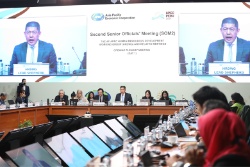WHO's Work in the Western Pacific Region Under Review
WHO News Release
WHO's Work in the Western Pacific
Region Under Review
HANOI, 24 September 2012—The
World Health Organization (WHO) in the Western Pacific
Region has decisively advanced its public health and reform
agenda even as it has tackled ongoing health crises and
prepared for future ones.
Addressing the Regional Committee for the Western Pacific Region, Dr Shin Young-soo, WHO Regional Director, said: "We continue to implement innovative approaches to increase efficiency and to sharpen focus on the challenges that you—our Member States—have told us are your priorities.”
“Our focus remains clear: to make a difference where it matters most—at country level,” he added.
Dr Shin's statement summed up his report to the Regional Committee for the Western Pacific, the regional governing body, on the Organization's work over the past year. The Regional Committee, composed of representatives from the Western Pacific's 37 countries and areas, meets once a year to review WHO's work in the Region and to determine future directions.
"WHO needs to be more nimble to adapt to rapidly changing realities, not only in public health, but also social and economic situations," Dr Shin said. "This requires that WHO's assistance be tailored-made for individual countries."
This approach can be seen in the Western Area Health Initiative, which aims to reduce health inequities in western China through a comprehensive strategy to boost economic and social development, targeting the most vulnerable communities.
In addition, WHO has supported the Governments of the Philippines and Viet Nam in their efforts on universal health coverage to bring health services to the country's poor.
“We focused over the past year on building capacity to engage countries on these issues and tackle the increasingly important issue of health equity,” Dr Shin said.
WHO's support in the Greater Mekong Subregion is also evident as Cambodia, the Lao People's Democratic Republic and Viet Nam work on common health issues, such as artemisinin-resistant malaria.
Dr Shin said he was proud of Australia’s efforts in introducing plain packaging for tobacco products—a move to fight the noncommunicable diseases for which tobacco use is a major risk factor.
The Western Pacific Region has remained polio-free despite an outbreak of wild polio virus in China. China responded by mounting a successful immunization campaign to ensure that the outbreak did not threaten gains made in the fight against this crippling and often fatal disease.
"We continue to look for ways to strengthen the Organization and improve our ability to meet the public health challenges of tomorrow," Dr Shin said.
"Sadly, the Region bears more than one quarter of the worldwide burden of multidrug-resistant tuberculosis. If not addressed, these strains could turn into incurable forms of the disease," Dr Shin warned. WHO has established a regional support mechanism that offers Member States country-specific assistance in the fight against multidrug-resistant tuberculosis.
The Western Pacific Region also faces more than its share of health emergencies and natural disasters, including last year's earthquakes in Japan and New Zealand. In response, WHO, in collaboration with Member States, has strengthened preparedness and response mechanisms.
Dr Shin
enumerated other challenges confronting the Region and
actions being taken in collaboration with Member
States:
• Noncommunicable diseases: WHO worked
with ministries of health and partners in developing
multi-sectoral national action plans and training
health-care workers on essential services for addressing
noncommunicable diseases, which are responsible for four out
of five deaths in the Region. WHO supports development of
healthy settings, as well as efforts to raise prices and
taxes on tobacco products to deter tobacco use, a main
driver of noncommunicable diseases, which include
cardiovascular and chronic respiratory diseases, cancers and
diabetes.
• Vaccine-preventable diseases: WHO
has redoubled efforts to eliminate vaccine-preventable
diseases, such as measles. During the first six months of
this year, there was a further decline of 60% in measles
cases over the same period of 2011.
•
International Health Regulations: WHO continues to support
Member States in implementing the International Health
Regulations to help countries prevent and respond to acute
public health risks that have the potential to cross borders
and threaten people worldwide.
• Blindness: WHO
intensified efforts to help more than 90 million visually
impaired people in the Region by addressing the main causes,
especially cataracts and trachoma, and supporting countries
in developing country action plans and integrating eye care
into primary health-care systems.
In all these efforts, Dr Shin urged Member States to strengthen health systems “to sustain past gains while continuing to meet the challenges we face—and prepare for those yet to come.”
Related link: The Work of WHO in the
Western Pacific Region: http://www.wpro.who.int/about/en/
ENDS


 Save The Children: It’s Not Safe And It’s Not Clean, But People Believe They Are Leaving Something Worse Behind
Save The Children: It’s Not Safe And It’s Not Clean, But People Believe They Are Leaving Something Worse Behind APEC: APEC Commits To Empowering People With Disabilities
APEC: APEC Commits To Empowering People With Disabilities UN News: Israeli Forces Bringing War To The West Bank, Warns UN Rights Office
UN News: Israeli Forces Bringing War To The West Bank, Warns UN Rights Office UN News: 10,000 People Feared Buried Under The Rubble In Gaza
UN News: 10,000 People Feared Buried Under The Rubble In Gaza Save The Children: Heat-stricken Bangladesh Extends School Closures
Save The Children: Heat-stricken Bangladesh Extends School Closures Hayden Stephens and Associates: Record Class Action Settlement Gives Hope To 50,000 Australian Junior Doctors
Hayden Stephens and Associates: Record Class Action Settlement Gives Hope To 50,000 Australian Junior Doctors